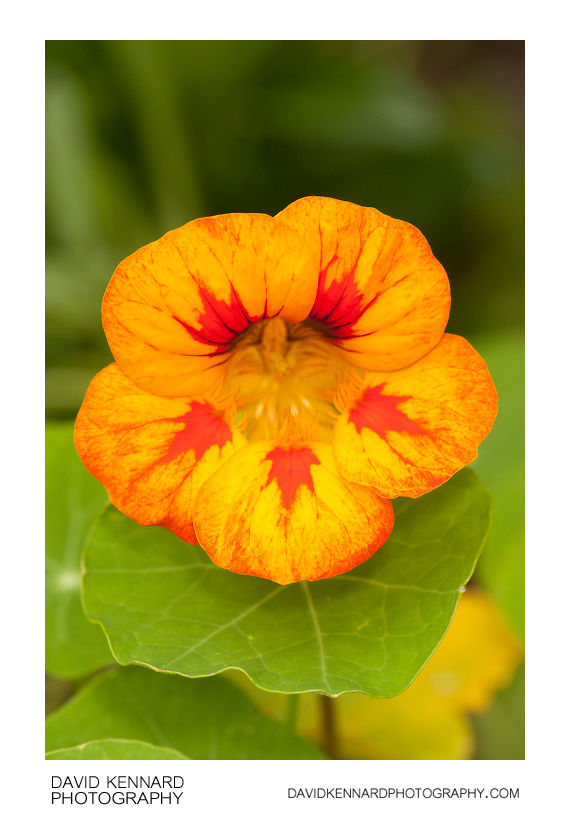Nasturtium 'Tom Thumb' (Tropaeolum majus)

Description
- Title:
- Nasturtium 'Tom Thumb' (Tropaeolum majus)
- Caption / Description:
-
Nasturtium (literally "nose-twister" or "nose-tweaker"), as a common name, refers to a genus of roughly 80 species of annual and perennial herbaceous flowering plants in the genus Tropaeolum ("trophy"), one of three genera in the family Tropaeolaceae. It should not be confused with the Watercresses of the genus Nasturtium, of the Mustard family. The genus Tropaeolum, native to South and Central America, includes several very popular garden plants, the most commonly grown being T. majus, T. peregrinum and T. speciosum.
They have showy, often intensely bright flowers (the intense color may pose problems in macrophotography), and rounded, peltate (shield-shaped) leaves with the petiole in the center. The flowers have five petals (sometimes more), a three-carpelled ovary, and a funnel-shaped nectar tube in the back.
Tropaeolum species are used as food plants by the larvae of some Lepidoptera species including Dot Moth and Garden Carpet. A very common "pest" found on Nasturtium in particular is the caterpillar of the Large White (Cabbage White) Butterfly.
The Nasturtiums receive their name from the fact that they produce an oil that is similar to that produced by Watercress (Nasturtium officinale), from the family Brassicaceae.
- Tags / Keywords:
-
- Biota
- Life
- Vitae
- Eukaryota
- Plantae
- Plants
- Magnoliophyta
- Flowering Plants
- Angiosperms
- Magnoliopsida
- Dicotyledons
- Brassicales
- Tropaeolaceae
- Tropaeolum
- Nasturtium
- Tropaeolum majus
- Garden Nasturtium
- Indian Cress
- Monks Cress
- Tropaeolum majus 'Tom Thumb'
- Nasturtium 'Tom Thumb'
Admin
- Date Original Photo Taken:
- Original File Name:
- _MG_5265.CR2
- Event:
- Rating:
- ☆
- Date this image added/last updated on website:
- Original File Dimensions:
- 2848px x 4272px
- File Type:
- JPEG
- Color Mode:
- RGB
- Original Image Color Profile:
- Adobe RGB (1998)
Location
- Location Created:
-
- Sublocation:
- City:
- Market Harborough
- Province/State:
- Leicestershire
- Country:
- United Kingdom
- World Region:
- Europe
- Geo-location:
Rights
- Copyright Status:
- Copyrighted
- Licensing Status:
- Rights Managed
- Available for Editorial Use:
- Yes
- Available for Commercial Use:
- Yes
- Copyright Notice:
- © 2010 Dave Kennard
Camera Data
- Date Digital Resource was created:
- Shutter speed:
- 1⁄200 s
- Aperture:
- f/5.6
- Camera Model:
- Canon EOS 450D
- ISO:
- 400
- Exposure Compensation:
- 0
- Focal Length:
- 100mm
- Focal Length (35mm equiv.):
- Metering Mode:
- Multi-segment
- Flash:
- On, Fired
- Exposure Mode:
- Manual
- White Balance:
- Manual
- Light Source:
- Exposure Program:
- Manual
Additional shooting metadata
- Lens:
- Canon EF 100mm F2.8 Macro USM
- Filters used:
- Additional Optics used:
- Setup:
- Handheld
Canon MT-24EX Macro Twin Flash with home-made concave diffusers
Post Processing
- Image Modified:
- Software used:
-
- Adobe Camera RAW
- Post Processing:
3 recovery in ACR
